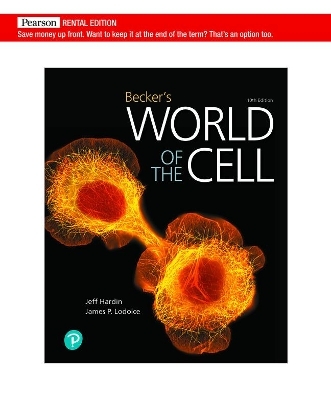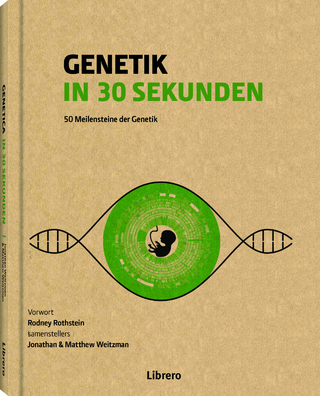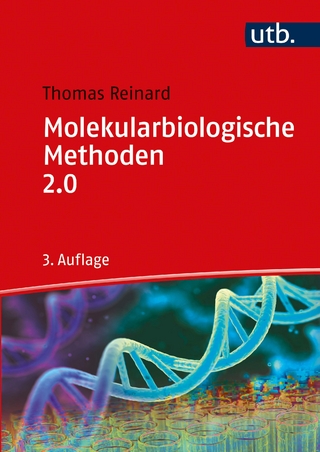
Becker's World of the Cell
Pearson (Verlag)
978-0-13-525949-8 (ISBN)
- Titel ist leider vergriffen;
keine Neuauflage - Artikel merken
For courses in cell biology.
Connecting fundamental concepts across the world of the cell
Known for its strong biochemistry coverage and clear, easy-to-follow explanations and figures, Becker's World of the Cell provides a beautifully illustrated, up-to-date introduction to cell biology concepts, processes, and applications. Informed by years of classroom experience in the cell biology course, the text features accessible and authoritative descriptions of all major principles, as well as unique scientific insights into visualization and applications of cell and molecular biology. With the 10th Edition, the authors guide students to make connections throughout cell biology, and provide questions that encourage students to practice interpreting and analyzing data. Embedded features in Pearson eText add interactivity, walking students through key figures with narrated explanations.
About our authors JEFF HARDIN received his Ph.D. in Biophysics from the University of California-Berkeley. He is Raymond E. Keller Professor and Chair of the Department of Integrative Biology at the University of Wisconsin -Madison, where he has been since 1991. For 18 years he was Faculty Director of the Biology Core Curriculum, a four-semester honors biology sequence for undergraduates at Wisconsin known for its teaching innovations. Jeff's research focuses on how cells migrate and adhere to one another during early embryonic development. Jeff's teaching is enhanced by his extensive use of digital microscopy and his web-based teaching materials, which are used on many campuses in the United States and in other countries. Jeff was a founding member of the UW Teaching Academy, and has received several teaching awards, including a Lily Teaching Fellowship, a National Science Foundation Young Investigator Award, and a Chancellor's Distinguished Teaching Award. JAMES P. LODOLCE earned his Ph.D. in Immunology from the University of Chicago in 2002. His thesis examined the signals that promote the survival of memory lymphocytes. As a postdoctoral fellow in the laboratory of Dr. David Boone, he studied the genetics and regulation of inflammation in autoimmunity. Cell biology was the first class that James taught when he arrived at Loyola University Chicago in 2010. He currently holds the title of Senior Lecturer and teaches a variety of courses ranging from molecular biology to virology. James is an active member of the Department of Biology and was appointed Co-Chairperson of Loyola's 2021 Pre-Health Professions Advisory Committee. In his career at Loyola, James has received several teaching honors, including a nomination for the 2014 Ignatius Loyola Award for Excellence in Teaching, the 2016 Master Teacher Award in the College of Arts and Sciences, and the 2020 Edwin T. and Vivijeanne F. Sujack Award for Teaching Excellence. WAYNE M. BECKER taught cell biology at the University of Wisconsin-Madison for 30 years until his retirement. His interest in textbook writing grew out of notes, outlines, and problem sets that he assembled for his students, culminating in Energy and the Living Cell, a paperback text on bioenergetics published in 1977, and The World of the Cell, the first edition of which appeared in 1986. All his degrees are in biochemistry from the University of Wisconsin-Madison, an orientation that is readily discernible in his writing. His research interests were in plant molecular biology, focused on the expression of genes that encode enzymes of the photorespiratory pathway. Later in his career he focused on teaching, especially students from underrepresented groups. His honors include a Chancellor's Award for Distinguished Teaching, Guggenheim and Fulbright Fellowships, and a Visiting Scholar Award from the Royal Society of London. This text builds on his foundation, and is inspired by his legacy
A Preview of Cell Biology
The Chemistry of the Cell
The Macromolecules of the Cell
Cells and Organelles
Bioenergetics: The Flow of Energy in the Cell
Enzymes: The Catalysts of Life
Membranes: Their Structure, Function, and Chemistry
Transport Across Membranes: Overcoming the Permeability Barrier
Chemotrophic Energy Metabolism: Glycolysis and Fermentation
Chemotrophic Energy Metabolism: Aerobic Respiration
Phototrophic Energy Metabolism: Photosynthesis
The Endomembrane System
Cytoskeletal Systems
Cellular Movement: Motility and Contractility
Beyond the Cell: Cell Adhesions, Cell Junctions, and Extracellular Structures
The Structural Basis of Cellular Information: DNA, Chromosomes, and the Nucleus?
DNA Replication, Repair, and Recombination
Gene Expression I: The Genetic Code and Transcription
Gene Expression II: Protein Synthesis and Sorting
The Regulation of Gene Expression
Molecular Biology Techniques for Cell Biology
Signal Transduction Mechanisms I: Electrical and Synaptic Signaling in Neurons
Signal Transduction Mechanisms II: Messengers and Receptors
The Cell Cycle and Mitosis
Sexual Reproduction, Meiosis, and Genetic Recombination
Cancer Cells
APPENDICES
Visualizing Cells and Molecules
FEATURE BOXES BY CHAPTER Key Techniques
Chapter 1: Using Immunofluorescence to Identify Specific Cell Components
Chapter 2: Determining the Chemical Fingerprint of a Cell Using Mass Spectrometry
Chapter 3: Using X-ray Crystallography to Determine Protein Structure
Chapter 4: Using Centrifugation to Isolate Organelles
Chapter 5: Measuring How Molecules Bind One Another Using Isothermal Titration Calorimetry
Chapter 6: Determining Km and Vmax Using Enzyme Assays
Chapter 7: SDS—Polyacrylamide Gel Electrophoresis (SDS—PAGE) of Membrane Proteins
Chapter 8: Expression of Heterologous Membrane Proteins in Frog Oocytes
Chapter 9: Using Isotopic Labeling to Determine the Fate of Atoms in a Metabolic Pathway
Chapter 10: Visualizing Cellular Structures with Three-Dimensional Electron Microscopy
Chapter 11: Determining Absorption and Action Spectra via Spectrophotometry
Chapter 12: Visualizing Vesicles at the Cell Surface Using Total Internal Reflection Microscopy (TIRF)
Chapter 13: Studying the Dynamic Cytoskeleton
Chapter 14: Watching Motors Too Small to See
Chapter 15: Building an ECM from Scratch
Chapter 16: FISHing for Specific Sequences
Chapter 17: The Polymerase Chain Reaction
Chapter 18: Hunting for DNA-Protein Interactions
Chapter 19: Protein Localization Using Fluorescent Fusion Proteins
Chapter 20: Gene Knockdown via RNAi
Chapter 21: DNA Cloning
Chapter 22: Patch Clamping
Chapter 23: Calcium Indicators and Ionophores
Chapter 24: Measuring Cells Millions at a Time (FACS -Analysis)
Chapter 25: Using Mendel's Rules to Predict Human Disease
Chapter 26: "Rational" Drugs in the Fight Against Cancer
Human Connections
Chapter 1: The Immortal Cells of Henrietta Lacks (The origin of the first human cultured cell line)
Chapter 2: Taking a Deeper Look -- Magnetic Resonance Imaging (MRI) (How an MRI can image human tissues)
Chapter 3: Aggregated Proteins and Alzheimer Disease (Protein misfolding and human disease)
Chapter 4: When Cellular "Breakdown" Breaks Down (Diseases caused by lysosome dysfunction)
Chapter 5: The "Potential" of Food to Provide Energy (Calorie contents of foods)
Chapter 6: ACE Inhibitors: Enzyme Activity as the Difference Between Life and Death (Blood pressure medication based on snake venom)
Chapter 8: Membrane Transport, Cystic Fibrosis, and the Prospects for Gene Therapy
Chapter 9: What Happens to the Sugar? (Dietary food intake and metabolism)
Chapter 10: A Diet Worth Dying For? (The dangers of using uncouplers such as DNP to lose weight)
Chapter 11: How Do Plants Put on Sunscreen? (How the plant xanthophyll cycle dissipates excess solar energy)
Chapter 12: It's All in the Family (LDL receptors, cholesterol uptake, hypercholesterolemia)
Chapter 13: When Actin Kills (Listeria infection and actin polymerization)
Chapter 14: Dyneins Help Us Tell Left from Right (Motors and left-right axis specification)
Chapter 15: The Costly Effects of Weak Adhesion (Blistering diseases of the skin)
Chapter 16: Lamins and Premature Aging (Progeria and the nuclear envelope)
Chapter 17: Children of the Moon (Xeroderma pigmentosum and DNA repair)
Chapter 19: To Catch a Killer: The Problem of Antibiotic Resistance in Bacteria
Chapter 20: The Epigenome: Methylation and Disease (Rett syndrome and imprinting disorders)
Chapter 21: More Than Your Fingertips: Identifying Genetic "Fingerprints" (STRs in genetic identification)
Chapter 22: In the Search for the Fountain of Youth, Are People Paying for Poison? (Cosmetic uses of Botulinum toxin)
Chapter 23: How to Prevent a Heart Attack (Nitric oxide -signaling and vasoconstriction)
Chapter 24: What do Ethnobotany and Cancer Have in Common? (Taxol and cancer treatment)
Chapter 25: When Meiosis Goes Awry (Down syndrome and nondisjunction)
Chapter 26: Molecular Sleuthing in Cancer Diagnosis (Molecular analysis of breast cancer)
| Erscheinungsdatum | 31.12.2019 |
|---|---|
| Sprache | englisch |
| Themenwelt | Naturwissenschaften ► Biologie ► Genetik / Molekularbiologie |
| Naturwissenschaften ► Biologie ► Zellbiologie | |
| ISBN-10 | 0-13-525949-5 / 0135259495 |
| ISBN-13 | 978-0-13-525949-8 / 9780135259498 |
| Zustand | Neuware |
| Informationen gemäß Produktsicherheitsverordnung (GPSR) | |
| Haben Sie eine Frage zum Produkt? |
aus dem Bereich


